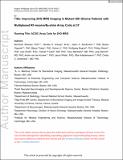Improving D‐2‐hydroxyglutarate MR spectroscopic imaging in mutant isocitrate dehydrogenase glioma patients with multiplexed RF‐receive/B 0 ‐shim array coils at 3 T
Author(s)
Strasser, Bernhard; Arango, Nicolas S.; Stockmann, Jason P.; Gagoski, Borjan; Thapa, Bijaya; Li, Xianqi; Bogner, Wolfgang; Moser, Philipp; Small, Julia; Cahill, Daniel P.; Batchelor, Tracy T.; Dietrich, Jorg; Kouwe, Andre; White, Jacob; Adalsteinsson, Elfar; Andronesi, Ovidiu C.; ... Show more Show less
Download10.1002-nbm.4621.pdf (2.391Mb)
Open Access Policy
Open Access Policy
Creative Commons Attribution-Noncommercial-Share Alike
Terms of use
Metadata
Show full item recordAbstract
MR spectroscopic imaging (MRSI) noninvasively maps the metabolism of human brains. In particular, the imaging of D-2-hydroxyglutarate (2HG) produced by glioma isocitrate dehydrogenase (IDH) mutations has become a key application in neuro-oncology. However, the performance of full field-of-view MRSI is limited by B0 spatial nonuniformity and lipid artifacts from tissues surrounding the brain. Array coils that multiplex RF-receive and B0-shim electrical currents (AC/DC mixing) over the same conductive loops provide many degrees of freedom to improve B0 uniformity and reduce lipid artifacts. AC/DC coils are highly efficient due to compact design, requiring low shim currents (<2 A) that can be switched fast (0.5 ms) with high interscan reproducibility (10% coefficient of variation for repeat measurements). We measured four tumor patients and five volunteers at 3 T and show that using AC/DC coils in addition to the vendor-provided second-order spherical harmonics shim provides 19% narrower spectral linewidth, 6% higher SNR, and 23% less lipid content for unrestricted field-of-view MRSI, compared with the vendor-provided shim alone. We demonstrate that improvement in MRSI data quality led to 2HG maps with higher contrast-to-noise ratio for tumors that coincide better with the FLAIR-enhancing lesions in mutant IDH glioma patients. Smaller Cramér–Rao lower bounds for 2HG quantification are obtained in tumors by AC/DC shim, corroborating with simulations that predicted improved accuracy and precision for narrower linewidths. AC/DC coils can be used synergistically with optimized acquisition schemes to improve metabolic imaging for precision oncology of glioma patients. Furthermore, this methodology has broad applicability to other neurological disorders and neuroscience.
Date issued
2021-10-05Department
Massachusetts Institute of Technology. Department of Electrical Engineering and Computer Science; Massachusetts Institute of Technology. Institute for Medical Engineering & ScienceJournal
NMR in Biomedicine
Publisher
Wiley
Citation
Strasser, B, Arango, NS, Stockmann, JP, et al. Improving D-2-hydroxyglutarate MR spectroscopic imaging in mutant isocitrate dehydrogenase glioma patients with multiplexed RF-receive/B0-shim array coils at 3 T. NMR in Biomedicine. 2022; 35( 1):e4621.
Version: Author's final manuscript
ISSN
0952-3480
1099-1492